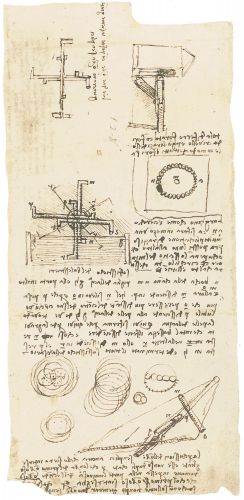Error
Analysis of Domenico Balestrieri’s perpetual wheel
Here Leonardo analyses a specific perpetual wheel, designated the “sophistic device of Balestrieri”. It consists of a pinwheel of tubes of different length bent at right angles, mounted so as to form a scale with unequal arms. In rotation, when the tube is full, the part with the longest arm has a greater moment and this should make the machine rotate.
The date traditionally attributed to this sheet is 1508-1510, but we cannot exclude the possibility that it is a few years earlier and dates back to the early 16th century, when Leonardo was studying the perpetual hydromechanical wheels drawn in folios 34v of the Codex Arundel and 40r of the Codex Atlanticus (see cat. no. 17). The explicit reference to the wheel of another engineer, identified as the Milanese painter Domenico Balestrieri, born in 1463, sheds light on the debate around perpetual motion machines among the artists and engineers of the time. To give an example from someone almost contemporary with Leonardo, Antonio da Sangallo the Young's notebook contains the drawing of a perpetual wheel called “Pasquino’s wheel” (GDSU, 1445Av), with which he thought he could power four piston pumps.


